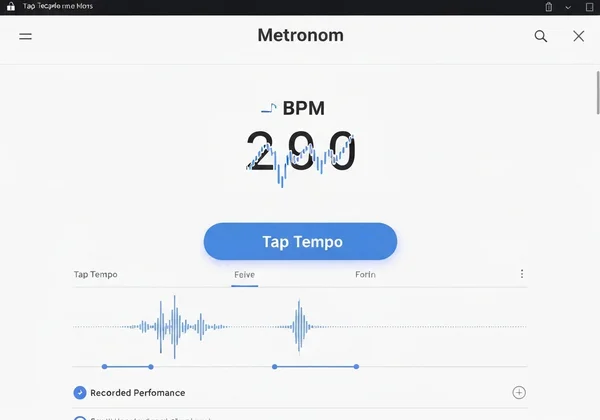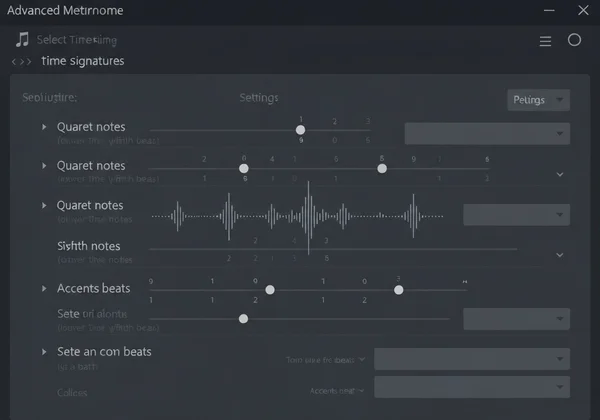Çevrimiçi Bir Metronomla Temponuzu Ustaca Yönetin: Tempo Kaymalarını Düzeltin
Şarkıyı grup arkadaşlarınızdan tam on saniye önce bitirdiğinizdeki o telaşlı his. Zor bir pasajda "ritmi sürüklediğiniz" yönündeki öğretmenden gelen sinir bozucu geri bildirim. Eğer bir müzisyen, dansçı veya sahne sanatçısıysanız, tutarsız bir tempoyla mücadele etmek yaygın ve oldukça rahatsız edici bir sorundur. Vuruşun nerede olması gerektiğini bilirsiniz, ancak iç saatiniz adeta kendi bildiğini okuyor gibi görünür. Peki ya o saati bir İsviçre saati kadar güvenilir olacak şekilde eğitebilseydiniz? Çevrimiçi bir metronom, hızlanmayı düzeltmeme nasıl yardımcı olabilir?
Cevap, doğru araçla disiplinli, bilinçli pratik yapmada yatar. Bir çevrimiçi metronom sadece bir tıklayıcı değildir; o sizin sarsılmaz ritim koçunuz, tempo tutarlılığı için kişisel antrenörünüzdür. Alışkanlıklarınızı teşhis etmek ve sağlam bir iç nabız oluşturmak için ihtiyacınız olan objektif gerçeği sağlar. Bu rehber, zamanlamanızı sabitlemek için güçlü ve erişilebilir ücretsiz çevrimiçi bir metronom kullanarak hızlanma ve yavaşlamayı sonsuza dek fethetmenize yardımcı olacak uygulanabilir egzersizler sunacaktır.

Hızlanma ve Yavaşlamayı Anlamak: Temponuz Neden Dengesizleşir?
Bir sorunu çözmeden önce, kaynağını anlamanız gerekir. Tempo tutarsızlığı "kötü" bir müzisyen olmanın bir işareti değildir; bu, deneyimli profesyonellerin bile aktif olarak yönetmesi gereken yaygın bir durumdur. Önemli olan, bilinçsizce dalgalanmaktan zamanlamanızı bilinçli olarak kontrol etmeye geçmektir. Bu, temponuzun neden dalgalandığını ilk etapta belirlemekle başlar.
Müzisyenlerde Tutarsız Tempoya Ne Sebep Olur?
Birkaç faktör iç saatinizi dengeden çıkarabilir. Teknik zorluk başlıca etkenlerden biridir; zorlu bir müzikal bölümle karşılaştığınızda, beyniniz doğru notaları çalmaya daha fazla kaynak ayırır, genellikle zamanlamadan feragat ederek yavaşlamanıza neden olur. Tersine, kolay veya heyecan verici bir pasaj sırasında adrenalin devreye girebilir ve ritmin önüne geçmenize neden olabilir.
Diğer nedenler arasında aktif dinleme eksikliği – bir metronomla birlikte çalmak yerine metronoma göre çalmak – veya bir performans sırasında basit bir gerginlik sayılabilir. Bir enstrümanın fiziksel talepleri de rol oynayabilir. Bir gitarist hızlı bir pena vuruşunda hızlanabilirken, bir vokalist nefes almaya çalışırken uzun bir cümlenin sonunda yavaşlayabilir. Bu tetikleyicileri tanımak, onlara hakim olmanın ilk adımıdır.
Tempo Sorunlarınızı Kendi Kendinize Nasıl Teşhis Edersiniz?
Ölçemediğiniz şeyi düzeltemezsiniz. Bir dedektif olma ve temponuzun tam olarak nerede ve ne zaman sapmaya meyilli olduğunu bulma zamanı. Bu basit teşhis egzersizi, ritmik alışkanlıklarınız hakkında size paha biçilmez veriler sağlayacaktır.
-
Kendinizi Kaydedin: İyi bildiğiniz basit bir parça, gam veya egzersiz seçin. Kendinizi baştan sona metronom olmadan çalarken kaydedin. Mükemmel olmaya çalışmayın; sadece doğal olarak çalın.
-
Tap Tempo Özelliği ile Analiz Edin: Şimdi kaydınızı tekrar dinleyin. Çevrimiçi metronom aracımızı açın ve benzersiz Tap Tempo özelliğimizi kullanın. Kaydınız çalarken, "Tap" düğmesine kendi performansınıza uygun olarak dokunun.
-
BPM'yi Gözlemleyin: Dokunurken BPM (Dakika Başına Vuruş) ekranını izleyin. Belirli bölümlerde sayı yukarı doğru tırmanıyor mu? Bu hızlanmadır. Notalar zorlaştığında düşüyor mu? Bu yavaşlamadır. Bu basit test, belirsiz hisleri somut verilerle değiştirerek, tam olarak ne üzerinde çalışmanız gerektiğini gösterir.

Sağlam Ritim Oluşturma: Tempo Tutarlılığı İçin Egzersizler
Net bir teşhisle, şimdi eğitime başlayabilirsiniz. Bu egzersizler, iç zaman duygunuzu sıfırdan sistematik olarak yeniden inşa etmek için tasarlanmıştır. Sabır gerektirirler, ancak getirisi muazzamdır: her türlü müzikal durumda güvenebileceğiniz istikrarlı, güvenilir bir ritim.
Yavaş Pratiğin Gücü: Sağlam Bir Temel Oluşturmak
Hızlanma ve yavaşlamayı düzeltmenin tek en etkili yolu yavaş pratik yapmaktır. Acı verici derecede yavaş. Bu, beyninizi her bir vuruşu ve alt bölümü işlemeye zorlar, derin ve sarsılmaz bir ritmik temel oluşturur. Hızlanma genellikle detayları gözden kaçırmanın bir belirtisidir; yavaş pratik bunu imkansız kılar.
Egzersiz:
- Ücretsiz metronomumuza gidin ve BPM'yi 50 olarak ayarlayın. Evet, 50.
- Bir gam veya kısa, tanıdık bir müzikal ifade seçin.
- Pasajı çalın, her bir notanın tıklamayla mükemmel bir şekilde eşleştiğinden emin olun. Amacınız enstrümanınızın sesi ile metronom tıklamasının bir bütün haline gelmesini sağlamaktır.
- Vuruşlar arasındaki boşluğa odaklanın. Her notanın tam süresini hissedin. Art arda on kez mükemmel bir şekilde çalabildiğinizde, tempoyu 2-3 BPM artırabilirsiniz. Süreci tekrarlayın.
Sessiz Barlar: İç Metronomunuzu Test Etmek
Sabit bir tıklamayla çalmaktan rahat hissettiğinizde, onu gerçekten içselleştirip içselleştirmediğinizi test etme zamanı. Sessiz bar egzersizi, destek tekerleklerini çıkarmak gibidir; harici kılavuz kaybolduğunda tempoyu korumanız için sizi zorlar.
Egzersiz:
- Metronomunuzu 4/4 zamanında 80 BPM gibi rahat bir tempoya ayarlayın.
- Metronom tıklaması ile dört tam ölçü boyunca bir gam veya rif çalın.
- Şimdi, metronomu sessize alarak sonraki dört ölçü boyunca çalmaya devam edin. Tamamen iç ritim duygunuza güvenmelisiniz.
- Dokuzuncu ölçünün ilk vuruşunda metronomun sesini açın. Tamamen zamanında mıydınız? Erken geldiyseniz, hala hızlanıyorsunuz demektir. Geç kaldıysanız, yavaşlıyorsunuz demektir. Bu, zamanlamanızı zorlamak ve gerçek ritmik bağımsızlık inşa etmek için harika bir yoldur.
Vuruşun Önünde ve Arkasında Çalmak (Stratejik Olarak)
Mükemmel zamanlama her zaman vuruşun tam ortasında çalmak anlamına gelmez. Profesyonel müzisyenler, bilerek vuruşun biraz önüne (ritmi öne çekerek) veya arkasına (ritmi geride bırakarak) çalarak farklı "hissiyatlar" yaratırlar. Bunu kasıtlı olarak pratik etmek, zamanlamanız üzerinde nihai kontrol sağlar.
Egzersiz:
- BPM aracını orta bir tempoya ayarlayın (yaklaşık 90-110 BPM).
- İlk olarak, sürekli olarak tıklamanın sadece bir tık arkasında çalmaya çalışın. Tıklamanın sizi çektiğini hayal edin. Bu, funk ve soul müzikte yaygın olan rahat, "cebe oturan" bir his yaratır.
- Ardından, tıklamanın sadece bir saniye önünde çalmaya çalışın. Bu, genellikle punk ve yüksek enerjili rock'ta kullanılan bir aciliyet ve sürüş hissi yaratır. Bu nüans seviyesine hakim olmak, metronomu katı bir cetvelden esnek bir kılavuza dönüştürür.
Zamanlama İçin Gelişmiş Metronom: Özelleştirilebilir Özelliklerden Yararlanma
Basit bir tıklama iyidir, ancak tam özellikli bir zamanlama metronomu ilerlemenizi hızlandırabilir. Çevrimiçi metronomumuzda bulunan özelleştirilebilir seçenekler, belirli ritmik zorlukların üstesinden gelmek ve iç saatinizi hassasiyetle geliştirmek için tasarlanmıştır.
Hassas Kontrol İçin Vurguları ve Alt Bölümleri Özelleştirme
Bazen, özellikle karmaşık ritimler için basit bir çeyrek nota tıklaması yeterli değildir. Alt bölümleri kullanmak, her vuruş içindeki daha küçük ritmik artışlara kilitlenmenize yardımcı olur.

Egzersiz:
- Ücretsiz metronom aracımızda, 4/4 gibi bir zaman işareti seçin.
- Basit bir tıklama yerine, metronomu sekizlik notalar veya hatta onaltılık notalar çalacak şekilde ayarlayın. Bu sürekli ritmik yapıya eşlik etmek, herhangi bir sapma hemen fark edildiği için hızlanmayı veya yavaşlamayı çok daha zorlaştırır.
- Ek olarak, vurgu özelliğini kullanın. Her ölçünün 1. vuruşuna güçlü bir vurgu ayarlayın. Bu, ölçünün formunu ve hissini içselleştirmenize yardımcı olur ve yerinizi kaybetmenizi önler.
İç Nabzınızı Kalibre Etmek İçin Tap Tempo Kullanma
Tap Tempo özelliği, bir şarkının hızını bulmak için kullanışlı bir yoldan daha fazlasıdır. İç ritim duygunuzu kalibre etmek için güçlü bir biyolojik geri bildirim aracıdır.
Egzersiz:
- Kafanızda bir tempo düşünün. Bu, yazdığınız bir şarkı için veya sadece rastgele bir nabız olabilir.
- Herhangi bir harici referans olmadan, bu içsel hissi kesin bir BPM numarasına dönüştürmek için tap tempo özelliğini kullanın.
- Şimdi, metronomu bu BPM'de başlatın. Tıklama, kafanızda duyduğunuz tempoyla eşleşiyor mu? Bunu ne kadar çok yaparsanız, farklı tempoları doğru bir şekilde tahmin etme ve hissetme konusunda o kadar iyi olursunuz, müzikal sezginiz ile objektif zaman arasındaki boşluğu doldurursunuz.
Mükemmel Zamanlama Yolculuğunuz Burada Başlıyor
Hızlanma ve yavaşlama bir müzisyen için ömür boyu sürecek cezalar değildir. Bunlar, beceri, hassasiyet ve güvenle kırılabilecek ve yerine yenisi konulabilecek alışkanlıklardır. Temel nedenleri anlayarak, kişisel eğilimlerinizi teşhis ederek ve metodik pratiğe bağlı kalarak, hem istikrarlı hem de esnek bir iç saat geliştirebilirsiniz. Yolculuk sabır gerektirir, ancak sonuç ritmik ustalıktır.

Tutarsız temponun müziğinizi engellemesine izin vermeyin. Bu rehberdeki araçlar ve egzersizler, olmak istediğiniz güvenilir, ritmi yakalayan sanatçı olmanız için yol haritanızdır. Ücretsiz çevrimiçi metronomumuzu açın, ilk yavaş BPM'nizi ayarlayın ve temponuzu bugün ustalaşmak için ilk adımı atın.
Sıkça Sorulan Sorular
Zamanlama geliştirmek için ideal pratik temposu (BPM) ne olmalı?
İyi bir başlangıç BPM'si inanılmaz derecede yavaş hissettiren, genellikle 40-70 BPM arası bir değerdir. Amaç hız değil; mutlak doğruluktur. Yavaş bir tempoda pratik yapmak, notalar arasındaki boşluğa dikkat etmenizi sağlar ve sağlam bir temel oluşturur. Hızı ancak bir pasajı art arda birkaç kez kusursuzca çalabildiğinizde artırmalısınız.
Çevrimiçi bir metronom hızlanmayı düzeltmeme nasıl yardımcı olabilir?
Çevrimiçi bir metronom, zamanlamanızın tarafsız bir yargıcı gibi davranır. Durmak bilmeyen, sabit tıklama, ne zaman hızlandığınızı anında ortaya çıkaran dışsal bir referans noktası sağlar. Bu objektif kılavuzla tutarlı bir şekilde pratik yaparak, beyninizi ve kas hafızanızı sabit bir nabzı tanımak ve ona uymak için yeniden eğitir, hızlanma alışkanlığını yavaş yavaş silersiniz.
Metronomla pratik yapmak ritmimi uzun vadede gerçekten geliştirebilir mi?
Kesinlikle. Tutarlı metronom pratiği, iç saatinizi geliştirmenin en etkili yollarından biridir. Zamanla, tıklamaya bilinçli olarak ayak uydurmaya çalışmaktan, içsel ritim duygunuzu bilinçsizce kullanmaya geçersiniz. Bu sizi hem solo pratikte hem de başkalarıyla çalarken daha sağlam ve güvenilir bir müzisyen yapar. Özelleştirilebilir metronomumuz bu uzun vadeli ritmik gelişim için mükemmel bir ortaktır.